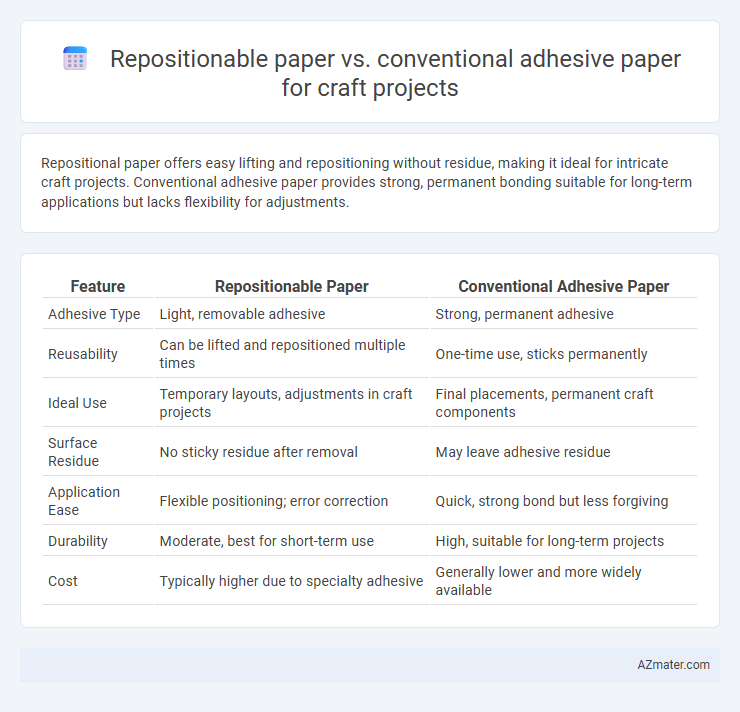Repositional paper offers easy lifting and repositioning without residue, making it ideal for intricate craft projects. Conventional adhesive paper provides strong, permanent bonding suitable for long-term applications but lacks flexibility for adjustments.
Table of Comparison
| Feature | Repositionable Paper | Conventional Adhesive Paper |
|---|---|---|
| Adhesive Type | Light, removable adhesive | Strong, permanent adhesive |
| Reusability | Can be lifted and repositioned multiple times | One-time use, sticks permanently |
| Ideal Use | Temporary layouts, adjustments in craft projects | Final placements, permanent craft components |
| Surface Residue | No sticky residue after removal | May leave adhesive residue |
| Application Ease | Flexible positioning; error correction | Quick, strong bond but less forgiving |
| Durability | Moderate, best for short-term use | High, suitable for long-term projects |
| Cost | Typically higher due to specialty adhesive | Generally lower and more widely available |
Introduction to Craft Paper Types
Craft projects often utilize repositional paper and conventional adhesive paper, each offering unique properties tailored to different creative needs. Repositional paper features a low-tack adhesive that allows temporary sticking and easy repositioning without residue, ideal for layouts and planning. Conventional adhesive paper provides a stronger bond for permanent applications, suited for final designs requiring durability and lasting adhesion.
What is Repositional Paper?
Repositional paper is a type of adhesive paper designed to allow temporary bonding that can be easily lifted and repositioned without leaving residue or damaging surfaces. This paper utilizes a low-tack adhesive that provides flexibility for craft projects requiring adjustments, such as scrapbooking, stenciling, or card making. Unlike conventional adhesive paper, which forms a permanent bond, repositional paper enhances precision and creativity by enabling repositioning multiple times during the crafting process.
What is Conventional Adhesive Paper?
Conventional adhesive paper features a permanent bonding layer designed to securely attach to surfaces, making it ideal for long-lasting craft projects. Its strong adhesive ensures materials stay firmly in place but can cause damage upon removal, limiting repositionability. This type of paper is preferred when durability and permanence are key requirements in crafting applications.
Key Differences Between the Two Papers
Repositional paper features a low-tack adhesive allowing users to easily lift and reposition it multiple times without residue, ideal for temporary labels and delicate craft adjustments. Conventional adhesive paper has a stronger, permanent bond designed for durable, long-lasting applications where repositioning is not needed. The key differences lie in adhesive strength, residue potential, and reusability, making repositional paper suited for flexible projects and conventional paper optimal for fixed, secure attachments.
Ease of Use for Craft Projects
Repositional paper offers superior ease of use for craft projects due to its ability to be easily lifted and repositioned without leaving residue, allowing for precise adjustments during design placement. Conventional adhesive paper, while providing a stronger initial bond, can be challenging to reposition and may damage delicate materials if lifted incorrectly. This flexibility with repositional paper significantly enhances workflow efficiency and reduces material waste in intricate craft applications.
Adhesion and Durability Comparison
Repositional paper offers moderate adhesion allowing temporary placement and easy repositioning without residue, making it ideal for precise craft layouts. Conventional adhesive paper provides strong, permanent adhesion ensuring durability and long-lasting bonds suitable for projects requiring firm attachment. Durabilitywise, conventional adhesive paper withstands stress and environmental factors better, while repositional paper may lose tackiness after repeated adjustments.
Removal and Reapplication: Pros and Cons
Repositional paper allows easy removal and multiple reapplications without damaging surfaces, making it ideal for temporary craft projects or precise placement adjustments. Conventional adhesive paper provides strong, permanent adhesion, which is beneficial for long-lasting projects but may cause surface damage or residue when removed. Choosing between the two depends on the need for flexibility in repositioning versus durability of the final application.
Impact on Materials and Surfaces
Repositional paper offers the advantage of temporary adhesion, minimizing damage to delicate materials and surfaces often encountered in craft projects. Conventional adhesive paper provides stronger, permanent bonding but can cause surface residue or damage when removed, making it less suitable for fragile or reusable materials. Selecting the appropriate adhesive type directly impacts the longevity and preservation of craft project components and underlying surfaces.
Cost and Availability Considerations
Repositional paper offers cost-effectiveness for short-term or trial craft projects due to its reusable adhesive, reducing waste and the need for additional supplies. Conventional adhesive paper, though often more expensive upfront, provides a stronger permanent bond ideal for final, long-lasting crafts, and is widely available in most craft stores. Both options vary in price based on brand and quality, but repositional paper tends to be more accessible online, while conventional adhesive paper dominates local retail shelves.
Which Paper is Best for Your Craft Project?
Repositional paper offers temporary adhesion that allows for easy adjustment and precise placement, making it ideal for delicate or detailed craft projects requiring flexibility. Conventional adhesive paper provides a strong, permanent bond suited for projects needing durability and long-lasting attachment. Choosing the best paper depends on whether your craft prioritizes repositioning ability or permanent adhesion.

Infographic: Repositional paper vs Conventional adhesive paper for Craft project
 azmater.com
azmater.com